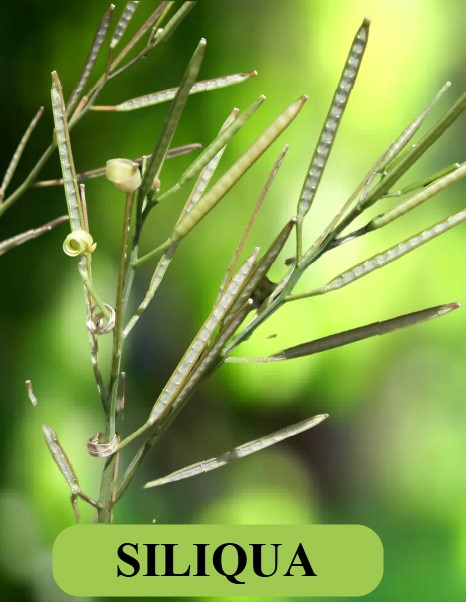
Siliqua is the fruit of
(a)Cruciferae
(b)Malvaceae
(c)Liliaceae
(d)Solanaceae
Answer
498.3k+ views
Hint: It is characterized by the presence of an elongated dry dehiscent seed pod and the fruits that have two fused carpels with the length is many times more than its width.
Complete answer:
Siliqua is a simple type of fruit of the Cruciferae family which is made up of two fused carpels. It elongated in a way that the length is more than three times the width. Now we take every option and match Siliqua belongs to which family. The Cruciferae family is commonly known as Brassicaceae, It is a mustard family, and they are an economically important plant. The size of the plant is usually medium. The most common example of the Cruciferae family includes mustard.
Malvaceae morphology, we can get by studying rose flowers in China rose flowers. Fruits like nuts and capsule and schizocarp type fruits are found in this family. Common e.g. are cotton and ladyfinger (okra).
Liliaceae is a lily family. They are flowering plants that represent the monocotyledons family. Mostly capsule type of fruits we get and rarely a berry.
Solanaceae is commonly known as potato families. Other edible plants tomato, chili, tobacco capsicum, brinjal belong to this family. It also includes a capsule or berry type of fruits.
So, the correct answer is ‘Cruciferae’.

Note: There are some species that are closely related to plants with true siliques that have fruits with a similar structure that do not open when ripe; these are usually called indehiscent siliques. Legume is a fruit type that somewhat resembles a silique, but is derived from one carpel that typically splits along two sides.
Complete answer:
Siliqua is a simple type of fruit of the Cruciferae family which is made up of two fused carpels. It elongated in a way that the length is more than three times the width. Now we take every option and match Siliqua belongs to which family. The Cruciferae family is commonly known as Brassicaceae, It is a mustard family, and they are an economically important plant. The size of the plant is usually medium. The most common example of the Cruciferae family includes mustard.
Malvaceae morphology, we can get by studying rose flowers in China rose flowers. Fruits like nuts and capsule and schizocarp type fruits are found in this family. Common e.g. are cotton and ladyfinger (okra).
Liliaceae is a lily family. They are flowering plants that represent the monocotyledons family. Mostly capsule type of fruits we get and rarely a berry.
Solanaceae is commonly known as potato families. Other edible plants tomato, chili, tobacco capsicum, brinjal belong to this family. It also includes a capsule or berry type of fruits.
So, the correct answer is ‘Cruciferae’.

Note: There are some species that are closely related to plants with true siliques that have fruits with a similar structure that do not open when ripe; these are usually called indehiscent siliques. Legume is a fruit type that somewhat resembles a silique, but is derived from one carpel that typically splits along two sides.
Recently Updated Pages
Master Class 11 Economics: Engaging Questions & Answers for Success

Master Class 11 Business Studies: Engaging Questions & Answers for Success

Master Class 11 Accountancy: Engaging Questions & Answers for Success

Master Class 11 English: Engaging Questions & Answers for Success

Master Class 11 Computer Science: Engaging Questions & Answers for Success

Master Class 11 Maths: Engaging Questions & Answers for Success

Trending doubts
State and prove Bernoullis theorem class 11 physics CBSE

1 ton equals to A 100 kg B 1000 kg C 10 kg D 10000 class 11 physics CBSE

State the laws of reflection of light

One Metric ton is equal to kg A 10000 B 1000 C 100 class 11 physics CBSE

1 Quintal is equal to a 110 kg b 10 kg c 100kg d 1000 class 11 physics CBSE

Difference Between Prokaryotic Cells and Eukaryotic Cells




